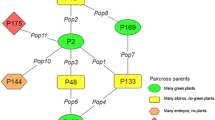Abstract
Genotypic influence of both male and female parents on haploid production through interspecific crosses was studied using eight wheat and four maize genotypes. The average numbers of embryos and green haploid plantlets obtained per pollinated floret were 17.6% and 10.1%, respectively. Clear genotypic influence of the wheat genotype was detected, but heterozygosity of the wheat did not affect haploid production. Analogous response to anther culture and interspecific crossing was observed, still a wheat variety which did not respond to anther culture, produced 1.1 plantlets per pollinated spike upon maize pollination. This appears to be a major advantage of interspecific crossing compared to anther culture technique in wheat. Circumstantial evidence is presented for specific wheat × maize interaction on haploid plantlet formation. Rye chromatin enhanced haploid production but only in a complete 1B/1R substitution line. Ovaries with an embryo were found to be dispersed evenly all over the wheat spike, suggesting that within certain limits the developmental stage of ovaries and thus time of pollination within a spike are not as important as it was previously assumed.
Similar content being viewed by others
References
Agache, S., B. Bachelier, J. de Buyser, Y. Henry & J. Snape, 1989. Genetic analysis of anther culture response in wheat using aneuploid chromosome substitution and translocation lines. Theor Appl Genet 77: 7-11.
Comeau, A., P. Nadeau, A. Plourde, R. Simard, O. Maes, S. Kelly, L. Harper, J. Lettre, B. Landry & C.A. St-Pierre, 1992. Media for the in ovule culture of proembryos of wheat and wheat-derived interspecific hybrids and haploids. Plant Science 81: 117-125.
Devaux, P., 1987. Comparison of anther culture and Hordeum bulbosummethod for the production of doubled haploids in winter barley. I. Production of green plants. Plant Breed. 98: 215-219.
Foroughi-Wehr, B., R. Pickering, and W. Friedt, 19881. Related response of barley cultivars to the 'bulbosum' and anther culture technique of haploid production. Berley-Genetics Newsletter 11: 54-59.
Foroughi-Wehr, B., and F.J. Zeller, 1990, In vitro microspore reaction of different Geman wheat cultivars. Theor. Appl. Genet. 79: 77-80.
Gamborg, O., R.A. Miller & K. Ojima, 1968. Nutrient requirement of suspension cultures of soybean root cells. Exp. Cell Res. 50: 151-158.
Henry, Y. & J. de Buyser, 1985. Effect of the 1B/1R translocation on anther culture ability in wheat (Triticum aestivumL.). Plant Cell Reports 4: 307-310.
Inagaki, M. & M. Tahir, 1990. Comparison of haploid production frequencies in wheat varieties crossed with Hordeum bulbosumL. and maize. Jpn J Breed 40: 209-216.
Laurie, D.A., 1989. Factors affecting fertilisation frequency in crosses of Triticum aestivumcv. 'Highbury' × Zea mayscv. "seneca 60'. Plant Breed 103: 133-140.
Laurie, D.A. & S, Reymondie, 1991. High frequencies of fertilisation and haploid seedling production in crosses between commercial hexaploid wheat varieties and maize. Plant Breed 106: 182-189.
Lelley, T. & R. Bothe, 1993. The effect of a complete 1B/1R substitution on quantitative traits in wheat. In: Proc. 8th Int. Wheat Genet. Symp., China Agr. Sci. Press, Beijing, pp. 233-235.
Löschenberger, F. & E. Heberle-Bors, 1992. Anther culture responsiveness of Austrian winter wheat (Triticum aestivumL.) cultivars. Die Bodenkultur 43: 115-122.
Sachs, L., 1992. Angewandte Statistik. Springer Verlag. Suenaga, K. & K. Nakajima, 1989. Efficient production of haploid wheat (Triticum aestivum) trough crosses between Japanese wheat and maize (Zea mays). Plant Cell Rep 8: 263-266.
Suenaga, K. & K. Nakajima, 1989. Efficient production of hap-loid wheat (Triticum aestivum) trough crosses between Japanese wheat and maize (Zea mays). Plant Cell Rep 8: 263–266.
Author information
Authors and Affiliations
Rights and permissions
About this article
Cite this article
Bitsch, C., Gröger, S. & Lelley, T. Effect of parental genotypes on haploid embryo and plantlet formation in wheat × maize crosses. Euphytica 103, 319–323 (1998). https://doi.org/10.1023/A:1018654000521
Issue Date:
DOI: https://doi.org/10.1023/A:1018654000521




